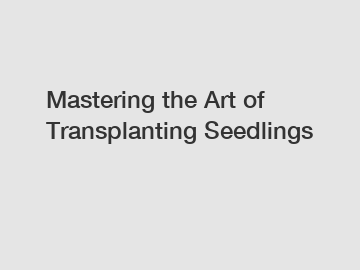Mastering the Art of Transplanting Seedlings
MARSHINE Product Page
Gardening enthusiasts and green thumbs alike understand the pure joy and satisfaction that accompanies watching seeds sprout and grow into healthy seedlings. But the journey doesn't end there; the key lies in successfully transplanting these young plants into their permanent homes, ensuring their continued growth and development. In this blog, we will take you through the art of transplanting seedlings, sharing valuable insights, tips, and techniques to help you master this critical stage of gardening. Whether you're a seasoned gardener or a beginner, follow our guidance and cultivate your plants with confidence!
1. Understanding Transplanting:

Transplanting is the process of carefully moving seedlings from their original pots or seed trays to larger containers, garden beds, or outdoor spaces. It allows plants to establish deeper, stronger roots, offering more space for nutrient absorption, ultimately aiding in their overall growth. While the concept may sound simple, mastering seedling transplanting requires a nuanced approach and attention to detail.
2. Timing is Everything:
Before starting the transplanting process, it's vital to assess the ideal time for the specific seedlings you're working with. While some plants thrive with early transplantation, others need more time to develop a robust root system. Understanding the specific timeline and requirements for each plant will prevent unnecessary stress or damage during the transfer.
3. Preparing the Seedlings:
To ensure a successful transplant, it's important to prepare your seedlings adequately. A few days before the scheduled transplant, start by gently watering them to soften the soil and ease their removal from pots. Additionally, this is an ideal time to introduce them to the outdoor environment by gradually exposing them to natural light, temperature changes, and wind. This acclimatization process primes them for the eventual move and minimizes shock.
4. Choosing the Right Location:
Selecting the appropriate spot for transplanting is crucial for a plant's healthy growth. Research the specific light, soil, and water requirements for your seedlings and find a location that best matches those needs. Consider factors such as sunlight availability, water drainage, soil quality, and proximity to neighboring plants. By providing optimal conditions, you're setting your seedlings up for success.
5. Soil Preparation:
Thorough preparation of the soil is just as important as choosing the right location. Ensure the chosen area is free from weeds and debris, as they may compete with your seedlings for nutrients and space. Consider adding organic matter such as compost or well-rotted manure to improve soil structure, drainage, and overall nutrient content. This will create an ideal environment for the new plants to establish themselves.
6. Transplanting Techniques:
When it comes to transplanting seedlings, gentle handling is key. Carefully remove each seedling from its original container, holding it by its leaves or using a small garden tool if necessary. Avoid holding or pulling on the stem, as this delicate part can easily break or damage.
Next, make a hole in the prepared soil slightly larger than the root ball of the seedling and gently place it inside. Ensure the seedling is planted at the same depth as it was in its original container, pressing the soil around it gently to eliminate air pockets. Remember to space the seedlings appropriately to allow for their future growth. Finally, water the newly transplanted seedlings thoroughly while keeping the surrounding soil slightly moist in the following weeks.
7. Post-Transplant Care:
After the transplant, it's important to monitor your seedlings closely for signs of stress or shock. Shield them from intense sunlight initially, using shade cloths or other protective measures. Regularly water the plants, being mindful not to overwater, which can cause root rot. Over time, gradually reduce the frequency of watering as the plants become established.
Conclusion:
Mastering the art of transplanting seedlings is both a science and an art. With experience, expertise, and a touch of creativity, you can confidently navigate this crucial step in gardening. By understanding the timing, preparing your seedlings, choosing the right location, and using proper techniques, you'll witness your plants thrive and grow into healthy, mature specimens. So embrace the journey, invest time and effort into your seedlings, and enjoy the fulfillment of nurturing them from tiny sprouts to flourishing plants. Happy transplanting and happy gardening!
You can find more information on our web, so please take a look.
Want more information on Nursery Pot Bracket wholesale? Feel free to contact us.



